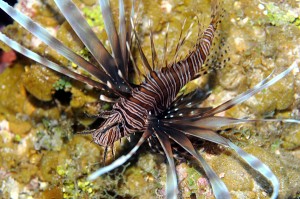The lionfish (Pterois volitans) are coral reef fishes from the tropical waters of the South Pacific and Indian Oceans. Now found in the western Atlantic Ocean, the most probable explanation for their arrival is via the aquarium trade. The lionfish is a nocturnal species and moves to deeper waters at night to forage. The species is relatively quick to adapt to novel prey types. Preliminary genetic studies from North Carolina suggest that as little as three females could be responsible for an entire population.
Impact
Lionfish were first seen in 1985 in North Carolina, USA, in Bermuda in 2001, the Bahamas in 2004 and are now listed as a priority IAS in Jamaica. They have spread throughout the Bahamas and the northern Caribbean. They are efficient carnivores that feed on a wide variety of smaller fishes, shrimps and crabs, out-competing native species. They also have the potential to decrease the abundance of ecologically important species such as parrotfish and other herbivorous fishes that keep seaweeds and macro-algae from overgrowing corals. The potential for loss to commercial fishers and reef-based tourism is severe. Venomous spines are also a serious threat to human health.
Control
Lionfish venomous dorsal, anal and pelvic spines make them almost immune to predators. Current options to manage the lionfish threat are limited. They are being removed individually at key locations through training and licensing of dive professionals to respond to sightings. Groupers, a known natural predator of the lionfish, will be part of control solutions. A few lionfish have been found in the stomachs of native groupers in the Bahamas. Other management solutions will include detection and response, medical issues, collection and handling techniques and monitoring and assessment protocols.
Affected Countries
Bahamas
Northern Caribbean
Distribution Map (CABI ISC):

